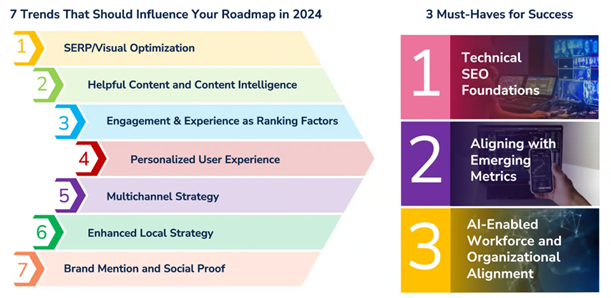SHARE

In the fast-paced digital landscape of 2025, staying on top of the latest SEO trends is crucial for the success of any website. One aspect that has become increasingly important is technical SEO. In this complete guide, we will dive deep into technical SEO and explore its fundamental principles, advanced strategies, common challenges, and how to measure success.
Understanding the Basics of Technical SEO
Before we delve into the details, let’s take a moment to understand the importance of technical SEO in 2025. In a nutshell, technical SEO refers to optimising the technical aspects of your website to improve its search engine visibility and user experience. Without a solid foundation of technical SEO, even the most well-crafted content and robust backlink profile may struggle to reach their full potential. Technical SEO ensures that search engines can crawl, index, and understand your website easily, making it more likely to rank higher in search results.

The Importance of Technical SEO in 2025
In 2025, search engines will become smarter than ever. Gone are the days when they solely relied on keyword matching to determine the relevance of a website. Today, they have advanced algorithms that consider not only the relevance of content but also numerous technical factors. Emphasising technical SEO helps you align your website with search engine expectations, increasing organic visibility and better user experience. When your website meets the technical requirements set by search engines, it becomes more accessible and user-friendly.
Imagine a scenario where your website takes ages to load, has broken links, or is not mobile-friendly. Visitors will quickly lose interest and abandon your site, leading to higher bounce rates. By focusing on technical SEO, you can address these issues and provide a smooth browsing experience for your users. Search engines prioritise websites that are technically optimised. When your website is easily crawlable, indexable, and understandable, search engines can efficiently determine its relevance to specific search queries. This, in turn, increases your chances of ranking higher in search results, driving more organic traffic to your site.
Looking for a trusted SEO agency? 2Stallions combines data-driven strategies with personalised service to help your business rank higher and grow online. Schedule a free consulation with us now.
Key Components of Technical SEO
When it comes to technical SEO, several key components demand your attention. Let’s take a closer look at some of these critical elements:
Site Speed Optimisation
Site speed plays a crucial role in user experience and search engine rankings. Slow-loading websites frustrate users and can lead to higher bounce rates. Search engines also take site speed into account when determining rankings. By optimising your website’s speed, you can provide a seamless browsing experience and improve your chances of ranking higher in search results.
Various techniques to improve site speed include:
- Compressing images.
- Minifying CSS and JavaScript files.
- Leveraging browser caching.
- Using a content delivery network (CDN).
Implementing these strategies can significantly enhance your website’s performance.
Mobile-Friendliness
In today’s mobile-dominated world, having a mobile-friendly website is no longer an option but a necessity. With the increasing number of users accessing the internet through mobile devices, search engines prioritise mobile-friendly websites in their rankings. Optimising your website for mobile devices involves creating a responsive design that adapts to different screen sizes and resolutions. This ensures that your content is easily accessible and readable on smartphones and tablets, providing a positive user experience across all devices.
Proper URL Structures
The structure of your website’s URLs plays a vital role in both user experience and search engine optimisation. A well-structured URL provides valuable information to users and search engines about the content of a page. When creating URLs, it’s essential to use descriptive keywords that accurately represent the page’s content. Avoid using generic or random strings of characters and instead opt for concise and meaningful URLs. Additionally, using hyphens to separate words in the URL improves readability for both users and search engines.
Effective Internal Linking
Internal linking refers to linking relevant pages within your website. It helps search engines understand the structure and hierarchy of your site, as well as the relationship between different pages. By strategically interlinking your content, you can guide users and search engines to essential pages on your website. This improves user experience and distributes link equity throughout your site, boosting the visibility of all your pages in search results.
When implementing internal links, use descriptive anchor text that accurately reflects the linked page’s content. This helps both users and search engines understand the context of the linked page. By paying attention to these critical components of technical SEO, you can lay a strong foundation for your website’s success. Remember, technical SEO is an ongoing process that requires regular monitoring and optimisation to keep up with the ever-evolving search engine algorithms.
 Future-Proofing your Website with Technical SEO
Future-Proofing your Website with Technical SEO
In an ever-evolving digital landscape, it’s essential to future-proof your website with technical SEO strategies that can withstand the test of time. Two major factors to focus on in 2025 are mobile-first indexing and Core Web Vitals.
The Role of Mobile-First Indexing
2025 marks the era of mobile-first indexing, where search engines predominantly use the mobile version of a website for indexing and ranking. Ensuring your website is mobile-friendly and offers a seamless user experience across different devices has never been more critical.
The Impact of Core Web Vitals
Core Web Vitals are a set of performance metrics that assess a website’s user experience. These metrics include factors like loading speed, interactivity, and visual stability. Adhering to Core Web Vitals helps to enhance user engagement, reduce bounce rates, and ultimately improve your website’s chances of ranking higher in search results.
Advanced Technical SEO Strategies for 2025
While the basics of technical SEO are crucial, advanced strategies can take your website to the next level. Below, we highlight two powerful techniques: harnessing the power of structured data and leveraging XML sitemaps for better indexing.
Harnessing the Power of Structured Data
Structured data, or Schema markup, provides search engines additional information about your website’s content. By implementing structured data correctly, you can enhance your website’s visibility in search results, attract more targeted traffic, and improve click-through rates.
Leveraging XML Sitemaps for Better Indexing
An XML sitemap is a file that lists all the essential pages on your website, helping search engines discover and understand your content more effectively. By regularly updating and submitting your XML sitemap, you can ensure that search engines crawl and index your website comprehensively, increasing your chances of ranking for relevant keywords.

Overcoming Common Technical SEO Challenges
Technical SEO has its challenges. However, identifying and addressing these common hurdles, you can navigate the complexities and boost your website’s performance. Let’s explore two such challenges: dealing with duplicate content issues and navigating JavaScript and SEO.
Dealing with Duplicate Content Issues
Duplicate content can confuse search engines, dilute your website’s authority, and impact your rankings. To tackle this issue, we’ll discuss techniques such as canonical tags, 301 redirects, and compelling content management strategies to ensure that search engines only index the most relevant version of your content.
Navigating JavaScript and SEO
JavaScript has become an integral part of modern websites but can pose challenges for search engines. We’ll delve into best practices for optimising JavaScript-heavy websites, ensuring that search engines can crawl and understand your content, and improving rankings and visibility.
Measuring the Success of Your Technical SEO Efforts
Now that you have implemented various technical SEO strategies, it’s crucial to measure their effectiveness and make data-driven decisions for continued improvement. Let’s explore essential technical SEO metrics to track and learn how to interpret this data for making informed optimisations.
Essential Technical SEO Metrics to Track
Dive into some of the key metrics that can help you gauge the success of your technical SEO efforts. From organic searsearch visibility and crawlability to page load times and mobile-friendliness, these metrics will give you valuable insights into the performance of your website.
Interpreting your SEO Data for Improvements
Data without insights is meaningless. Discover how to interpret your technical SEO data and analyse the trends, patterns, and opportunities it presents. Regularly analysing and acting upon this data lets you fine-tune your website’s technical aspects and stay ahead of the competition. By the end of this comprehensive guide, you’ll understand the importance of technical SEO in 2025, the key components that make up a technically sound website, advanced strategies to elevate your website’s performance, and techniques to overcome common challenges. With this knowledge, you’ll be well-equipped to navigate the ever-changing SEO landscape and optimise your website for success.
Frequently Asked Questions About Technical SEO
What's the Difference Between Technical SEO and On-Page SEO?
Technical SEO involves making sure that your website’s code is clean and effective. In contrast, on-page SEO has to do with the way that your website is formatted. You could say that technical SEO is focused on performance, while on-page SEO is focused on content.
What are the Technical SEO Categories?
For technical SEO, each responsibility falls within one of four categories: Site hierarchy. Crawl, index, render. Security.
How Do You Conduct Technical SEO?
- Step 1: Crawl your website
- Step 2: Check your site speed
- Step 3: Optimise your mobile-friendliness
- Step 4: Review your site’s security
Step 5: Audit your on-page SEO
Step 6: Analyse your off-page SEO
Why Do We Need Technical SEO?
Technical SEO holds immense importance because it directly impacts how your website performs in Google’s search results. Suppose search engines can’t easily access and understand your web pages. In that case, no matter how valuable your content is, those pages won’t appear or rank in search results.
Is Technical SEO Difficult?
Toggle content goes here, click eNo matter how much effort you put into improving your organic SEO and building up your traffic, if your website isn’t up to the technical tasks that search engines like Google expect it to perform, you may stunt your growth and waste your time. Technical SEO can be difficult.dit button to change this text.



 Future-Proofing your
Future-Proofing your 










